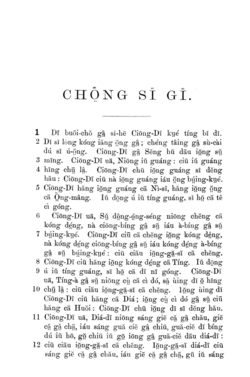Jian'ou dialect
The Jian'ou dialect (Northern Min: Gṳ̿ing-é-dī / 建甌事; Chinese: simplified Chinese: 建瓯话; traditional Chinese: 建甌話; pinyin: Jiàn'ōuhuà), also known as Kienow dialect, is a local dialect of Northern Min Chinese spoken in Jian'ou in northern Fujian province. It is regarded as the standard common language in Jian'ou.
| Jian'ou | |
|---|---|
| Gṳ̿ing-é-dī / 建甌事 | |
| Pronunciation | [kuiŋ˧ ɪ˥˦ ti˦] |
| Native to | Southern China |
| Region | Jian'ou, Fujian province |
| Chinese character, Kienning Colloquial Romanized | |
| Language codes | |
| ISO 639-3 | – |
| Glottolog | jian1240 |
| Jian'ou dialect | |||||||
|---|---|---|---|---|---|---|---|
| Traditional Chinese | 建甌話 | ||||||
| Simplified Chinese | 建瓯话 | ||||||
| |||||||
| Alternative Chinese name | |||||||
| Traditional Chinese | 建甌事 | ||||||
| Simplified Chinese | 建瓯事 | ||||||
| |||||||

Phonetics and phonology
According to The Eight Tones of Kien-chou (建州八音), a rime dictionary published in 1795, the Jian'ou dialect had 15 initials, 34 rimes and 7 tones in the 18th century, however there are only 6 tones in the modern dialect as the "light level" (陽平) tone has disappeared.
Initials
| Bilabial | Alveolar | Velar | Glottal | ||
|---|---|---|---|---|---|
| Nasal | m | n | ŋ | ||
| Plosive | voiceless unaspirated | p | t | k | ʔ |
| voiceless aspirated | pʰ | tʰ | kʰ | ||
| Affricate | voiceless unaspirated | ts | |||
| voiceless aspirated | tsʰ | ||||
| Fricative | s | x | |||
| Approximant | l | ||||
Rimes
| Open syllable | Nasal coda | |||||||||||||||
|---|---|---|---|---|---|---|---|---|---|---|---|---|---|---|---|---|
| Open mouth | a | e[4] | ɛ | œ | ɔ | o[5] | ai | au | aŋ | aiŋ | eiŋ | œyŋ | ɔŋ [6] | |||
| Even mouth | i | ia | iɛ | iɔ | iau | iu | iŋ | iaŋ | ieiŋ[7] | iɔŋ | ||||||
| Closed mouth | u | ua | uɛ [8] | uai | uiŋ [9] | uaŋ | uaiŋ | uɔŋ | ||||||||
| Round mouth | y | yɛ [8] | yiŋ [9] | |||||||||||||
Tones
Jian'ou has four tones, which are reduced to two in checked syllables.
| Tone number | Tone name | Tone contour |
|---|---|---|
| 1 | level (平聲) | ˥˦ (54) or ˥ (5) |
| 2 | rising (上聲) | ˨˩ (21) or ˩ (1) |
| 3 | dark departing (陰去) | ˨ (2) |
| 4 | light departing (陽去) | ˦ (4) |
| 5 | dark entering (陰入) | ˨˦ (24) |
| 6 | light entering (陽入) | ˦˨ (42) |
The entering tones in the Jian'ou dialect do not have any entering tone coda (入聲韻尾) such as /-ʔ/, /-p̚/, /-t̚/ and /-k̚/ which makes it distinct from many other Chinese varieties.
Notes
References
- Mei, Tsu-lin (1970), "Tones and prosody in Middle Chinese and the origin of the rising tone", Harvard Journal of Asiatic Studies, 30: 86–110, doi:10.2307/2718766, JSTOR 2718766
- Pulleyblank, Edwin G. (1984), Middle Chinese: A study in Historical Phonology, Vancouver: University of British Columbia Press, p. 3, ISBN 978-0-7748-0192-8
- Hammarström, Harald; Forkel, Robert; Haspelmath, Martin; Bank, Sebastian (2023-07-10). "Glottolog 4.8 - Min". Glottolog. Leipzig: Max Planck Institute for Evolutionary Anthropology. doi:10.5281/zenodo.7398962. Archived from the original on 2023-10-13. Retrieved 2023-10-13.
- /e/ tends to merge to [ɪ]
- /o/ tends to merge to [ʊ]
- /oŋ/ which is mentioned in Kienning Colloquial Romanized has merged into /ɔŋ/ in the modern dialect.
- /ieiŋ/ is not mentioned in Kienning Colloquial Romanized as it diverged from /iŋ/ after the romanization system was established.
- /yɛ/ tends to merge into /uɛ/.
- /yiŋ/ tends to merge into /uiŋ/.
Sources
- Beijing daxue Zhongguo yuyan wenxue xi yuyanxue jiaoyanshi 北京大學中國語言文學系語言學教研室 (1989). Hànyǔ fāngyīn zìhuì 漢語方音字匯 (in Chinese). Beijing: Wenzi gaige chubanshe.
- Yuan, Jiahua 袁家驊 (1989). Hànyǔ fāngyán gàiyào 漢語方言概要 [An Introduction to Chinese Dialects] (in Chinese). Beijing: Wenzi gaige chubanshe.
- Jianou Xian difangzhi bianzuan weiyuanhui 建瓯县地方志编纂委员会 (1994). Jiànōu xiànzhì 建瓯县志 [Chorography of Jian'ou County]. Vol. 36. Beijing: Zhonghua shuju. ISBN 7-101-01283-3. Archived from the original on 2018-04-07. Retrieved 2018-04-06.
- Lien, Chinfa (1990). "Competing Final Systems in the Jian'ou Dialect" (PDF). Tsing Hua Journal of Chinese Studies. 20 (1): 1–53.
- Norman, Jerry (2002) [1988]. Chinese. Cambridge: Cambridge University Press. ISBN 0-521-29653-6.
